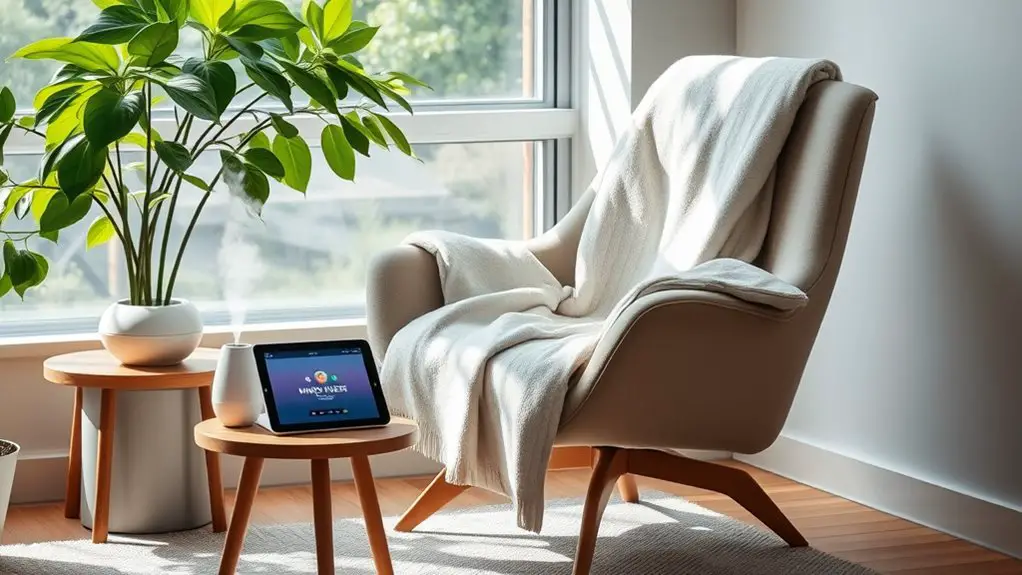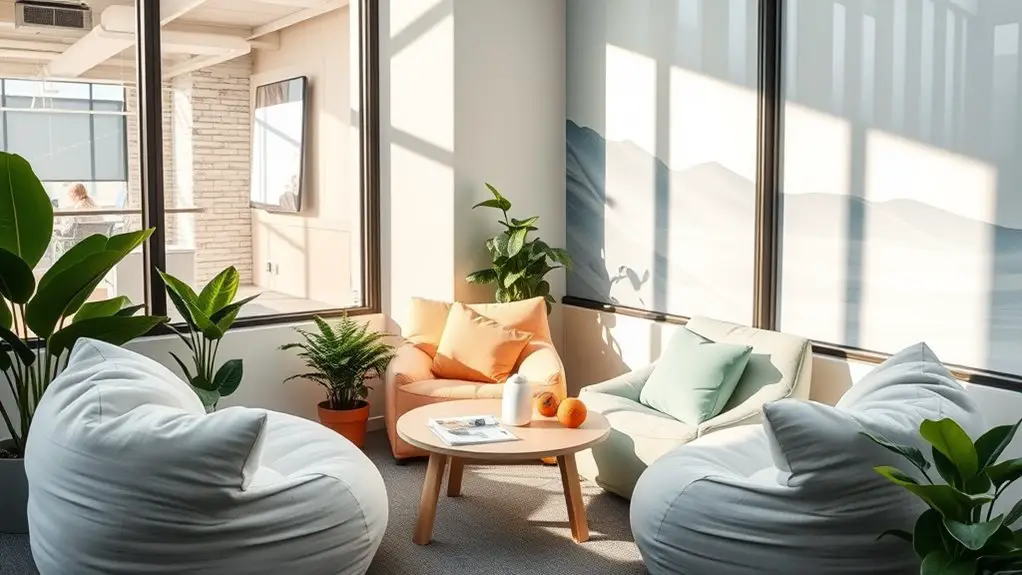To build a mental health break corner in your office, start by creating a relaxing space with comfortable seating and calming colors like blues and greens. Add plants for a touch of nature and soft lighting to set a soothing atmosphere. Incorporate technology like wellness apps for support and use emotion charts to help express feelings. Keep the area welcoming and inclusive to promote positive interactions. There's more to explore about enhancing employee well-being and productivity in this space.
Table of Contents
Key Takeaways
- Design the space with calming colors like blues and greens, and incorporate comfortable seating such as sofas or bean bags.
- Add soothing elements like calming plants, gentle lighting, and peaceful soundscapes to create a relaxing atmosphere.
- Integrate technology like wellness apps and wearable devices to provide accessible mental health support and track well-being.
- Ensure the environment is welcoming and inclusive by providing quiet areas for privacy and using emotion charts to facilitate expression.
- Involve employees in the planning process and encourage feedback to foster a sense of ownership and enhance overall job satisfaction.
Understanding the Importance of a Mental Health Break Corner

Creating a dedicated Mental Health Break Corner is essential for nurturing well-being in the workplace. These breaks not only increase your productivity and concentration but also serve as a preventative measure against chronic stress and burnout. When you take regular mental health breaks, you're actively reducing stress and promoting a healthier work environment. Additionally, job satisfaction influences mental health through purpose, growth opportunities, and positive relationships.
For employers, encouraging these breaks boosts overall workforce engagement and can substantially lower turnover rates. Additionally, establishing a space for mental health discussions fosters a culture of empathy and understanding. It allows you and your colleagues to share experiences and support one another, breaking down stigma around mental health.
Ultimately, a Mental Health Break Corner benefits everyone, creating a more engaged and resilient workforce.
Designing the Space for Relaxation and Comfort
Designing a Mental Health Break Corner that promotes relaxation and comfort involves careful consideration of various elements. Start with a calming color scheme—blues, greens, and neutrals work wonders. Make sure the lighting is soft and natural, with gentle LEDs to enhance the ambiance. Choose comfortable seating like sofas or bean bags, inviting people to unwind. Incorporate calming plants, such as lavender, to elevate the atmosphere. Add soothing soundscapes, like rainfall or ocean waves, to create a peaceful background. Decorate with mindful quotes and art that inspires positivity. Use various textures, like pillows and blankets, to provide tactile comfort. Finally, keep the space clean and welcoming, encouraging regular use and fostering a sense of community. Additionally, consider including elements from peer support programs that can enhance the sense of connection and understanding within the space.
Incorporating Technology for Enhanced Well-being

A well-designed mental health break corner can benefit substantially from the integration of technology, enhancing the overall experience for users. Incorporating digital tools like wellness apps and e-health interventions allows you to access support anytime, helping to reduce stigma around mental health. You can utilize AI-driven apps that offer personalized therapy formats, keeping you engaged and focused on your well-being. Additionally, leveraging collaboration tools like Microsoft Teams or Slack can connect you with therapists for video sessions, making support more accessible. Wearable devices can track your activity, encouraging you to stay active, which directly boosts your mental state. By investing in technology, you create a supportive environment that fosters resilience and promotes overall mental health. Furthermore, wellbeing at work acts as a crucial mediator in enhancing mental health outcomes through digitalization.
Creating a Welcoming and Inclusive Environment
When crafting a welcoming and inclusive environment, it's essential to focus on comfort and accessibility. Start by incorporating comfortable furniture, like plush chairs or bean bags, to encourage relaxation. Use calming colors such as blue or green to promote a serene atmosphere.
Hang peaceful artwork and add plants, like lavender, known for their calming effects. Make sure to designate a quiet area for privacy and utilize emotion charts to help employees express their feelings. A flexible layout with various seating options will cater to different needs.
Finally, consider adjustable lighting to enhance coziness. By prioritizing these elements, you'll create a space where everyone feels valued and at ease.
Encouraging Employee Engagement and Feedback

Creating a welcoming and inclusive environment sets the stage for effective employee engagement and feedback. Involve your team in decision-making; it fosters empowerment and trust, making them feel valued.
Encourage employees to define their goals and key performance indicators (KPIs) to align efforts with the organization's mission. Maintain positive managerial relationships and facilitate open communication through various channels. Actively solicit feedback and conduct regular surveys to gauge engagement levels. Implement strategies like internal mobility and job enrichment to enhance job satisfaction. Recognize achievements and provide necessary tools, ensuring every employee has what they need to thrive. Employee engagement is a two-way street requiring both employee reflection and organizational support.
Frequently Asked Questions
What Are the Costs Associated With Creating a Mental Health Break Corner?
Creating a mental health break corner involves initial setup costs for furniture and decor, ongoing maintenance expenses, and potential hiring of professionals. Not investing could lead to higher turnover and presenteeism costs, impacting overall productivity.
How Often Should Employees Be Encouraged to Use the Break Space?
You should encourage employees to use the break space regularly, ideally every hour. These breaks help recharge focus and reduce burnout, allowing them to return refreshed and more productive throughout the workday.
What Size Should the Mental Health Break Corner Be?
The mental health break corner should be spacious enough to accommodate diverse needs. Consider your available space, the number of employees, and verify that it's flexible for various activities, promoting comfort and accessibility for everyone.
Can We Incorporate Outdoor Spaces for Mental Health Breaks?
Incorporating outdoor spaces for mental health breaks can remarkably enhance your well-being. You'll find that fresh air, greenery, and natural light reduce stress and boost creativity, making your workday more enjoyable and productive.
How Do We Measure the Effectiveness of the Mental Health Break Corner?
To measure the effectiveness of the mental health break corner, you'll gather employee feedback through surveys, track usage metrics, and monitor changes in mood and productivity. Regular assessments will help you evaluate its impact on wellbeing.




